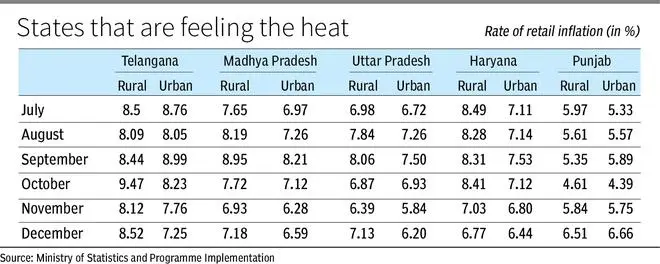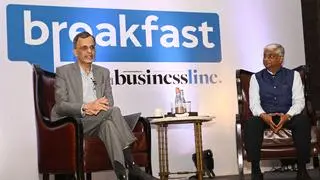Retail inflation, based on the Consumer Price Index for the month of December, was the the highest in two north-eastern States. While Mizoram clocked the highest rate of retail inflation at 13.94 per cent, Tripura saw the maximum urban inflation at 10.43 per cent.
According to data from the Statistics Ministry, a total of 23 States and Union Territories have shown higher rural inflation. Among the large States, Telangana, Madhya Pradesh, Uttar Pradesh, Haryana and Punjab have high rural inflation. Significantly, four of these five States have high dependency on the farm sector.

Poverty-debt trap
Manisha Malhotra, Associate Professor, Department of Economics, Banaras Hindu University, said the primary reason for rural retail inflation being higher is the larger weightage of food and beverage components in the rural CPI basket (54.18 per cent). This is only 36.29 per cent in the urban basket.
“The assumption is that rural Indians spend a higher portion of their income on food items. This implies that prices of food, beverages, milk and milk products are higher in rural areas compared with urban; hence, it will cause a direct impact on poverty. It will force mass rural population into the poverty-debt trap,” she said.
Anil Kumar Sood, Professor and co-founder, Institute of Advanced Studies in Complex Choices, said if the rural inflation results in rural households getting better prices for their produce and higher wages for their work, one would expect it to have a positive impact on the economic growth in rural areas. However, that is not the case.
“For example, the rise in milk price is being driven by increase in input costs, which in turn, is driven by fodder shortage and fuel price increases. Similarly, an increase in prices of clothing, footwear and personal care products adversely affects the rural purchasing power,” he said.
Hurting economy
The pandemic, too, has aggravated the scenario by reverse migration and adding to rural mass unemployment, said Malhotra, adding that this will increase rural indebtedness as consumption of basic necessary food items become dearer.
“We expect that the elevated rural inflation is likely to hurt the rural economy, as the pricing power is not with the rural households,” said Sood.








Comments
Comments have to be in English, and in full sentences. They cannot be abusive or personal. Please abide by our community guidelines for posting your comments.
We have migrated to a new commenting platform. If you are already a registered user of TheHindu Businessline and logged in, you may continue to engage with our articles. If you do not have an account please register and login to post comments. Users can access their older comments by logging into their accounts on Vuukle.